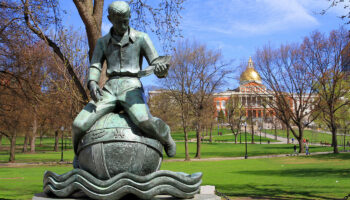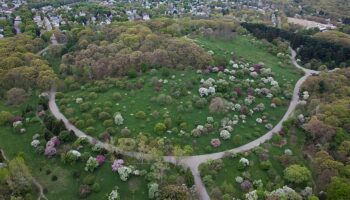My Massachusetts
The Merrimack River powered some of the world’s largest factories during the heyday of the textile industry, and in the Lowell area there are several reminders of that era. The Middlesex Canal, built between 1793 and 1803, linked Merrimack to the Port of Boston, playing an important role in the Industrial Revolution, which is being studied at the Middlesex Canal Museum in Billerica. The American Museum of Textile History traces textile production from the 18th century to the mid-1900s with exhibits of hand tools, machinery, textiles, and clothing. Another aspect of textile history is featured in the New England Museum, where you can admire intricate handicrafts in modern, traditional and antique quilts. For a break from textiles, see the work of James Abbott McNeill Whistler and other American artists in his homeland, the Whistler Museum of Art.

Boston Central Park, which dates back to the first half of the 17th century. It covers an area of 20 hectares. At first, this area belonged to the first settler from Europe W. Blackstone, then passed to the colonial authorities and began to be used as a pasture, a little later – a military camp and a place for executions. A full-fledged park appeared here only at the beginning of the 19th century.
Major tourist attractions related to Lowell in the Industrial Revolution are located in two open-air museums: Lowell National Historical Park and Lowell Amusement Park.When watching the video, hop on a cart for a tour, or take a boat ride along the canal in the summer. A tour of the Boott Cotton Mill Museum reveals a weaving room where 88 looms are hammered, fitted with an ingenious system of shafts, belts and pulleys, all driven by the Merrimack River. Nearby, a former workers’ boarding house concentrates on living conditions and explores the stories of textile workers, often farm girls or immigrants. Lowell’s textile mills were instrumental in the early days of the American labor rights movement.

The arboretum is located in the suburbs of Boston. It was created by the architect and landscape designer F.L. Olmsted. The place was named after the merchant and whaler James Arnold, who donated a considerable part of his fortune and lands for its creation. Today, the arboretum is not only a picturesque park, but also a research site at Harvard University.
A composition of six glass towers was erected in 1995 to honor the memory of the Jews who died during the Second World War. Each tower symbolizes the death camp: Auschwitz, Belzec, Treblinka, Chelmno, Majdanek and Sobibor. Inside the towers, the walls are engraved with the words of the people who survived the imprisonment in these terrible places.








